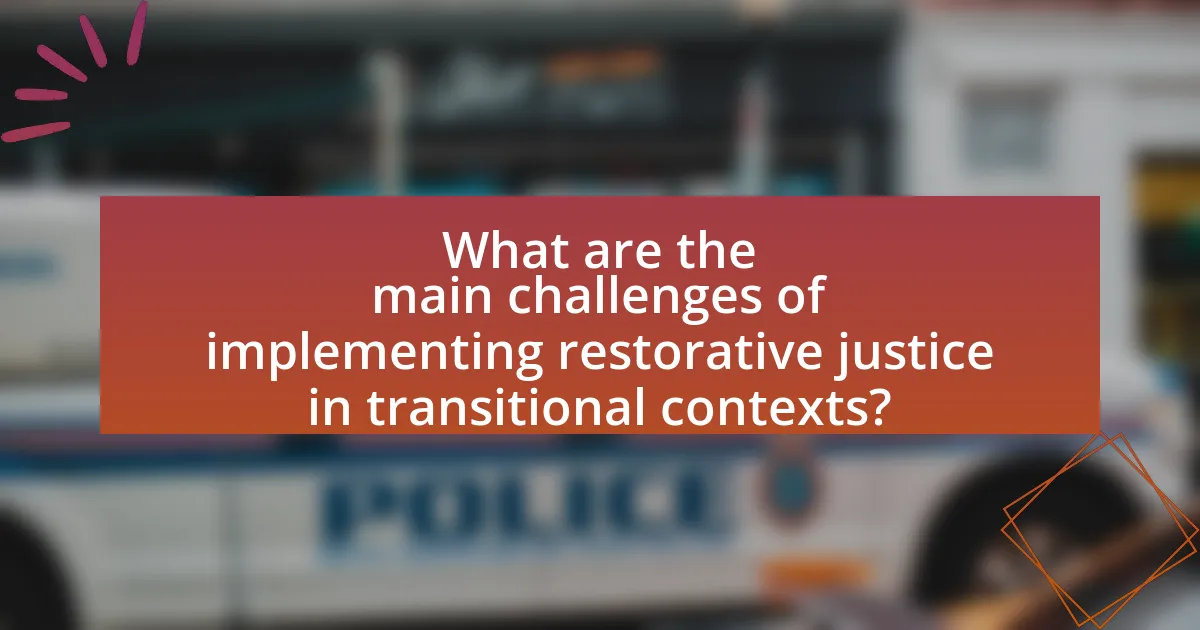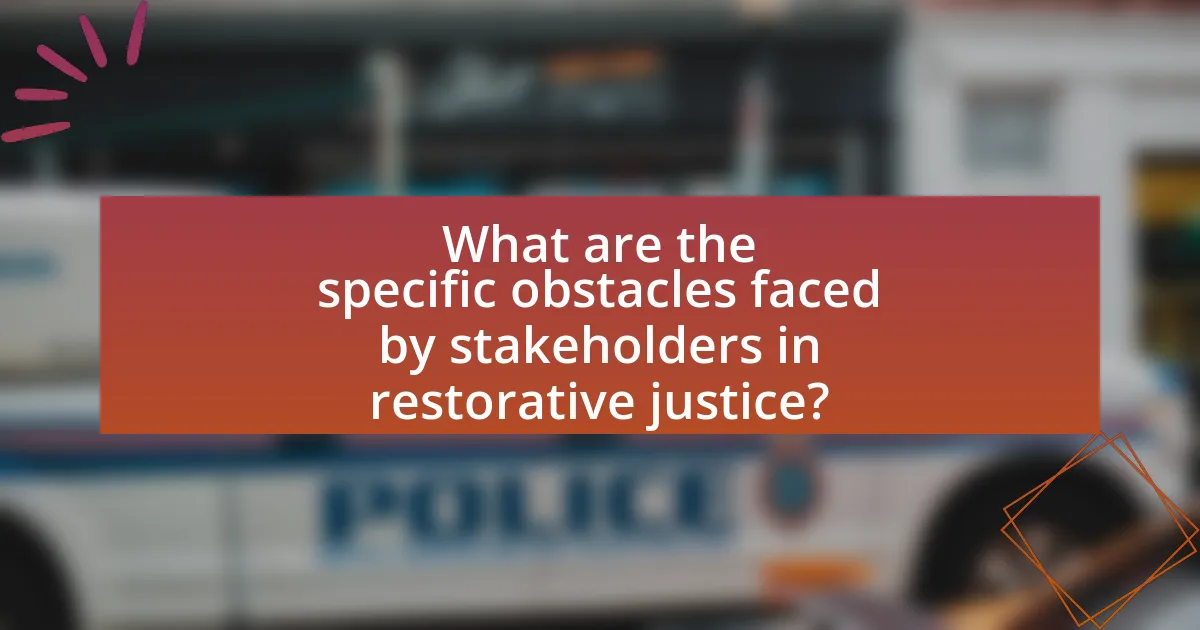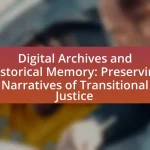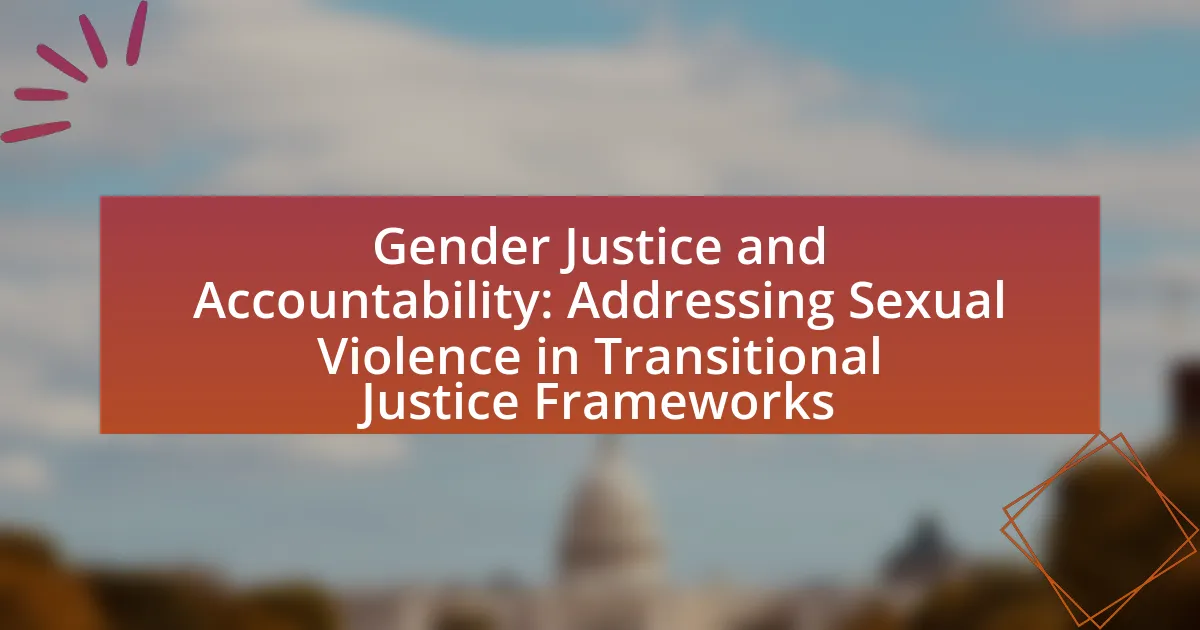The article examines the challenges of implementing restorative justice as an accountability mechanism in transitional contexts. Key obstacles include a lack of trust among communities, insufficient legal frameworks, cultural resistance to alternative justice models, and the influence of political climates. It highlights how these factors affect community engagement, victim and offender participation, and the overall effectiveness of restorative justice initiatives. The article also discusses the importance of legal reforms, community dynamics, and educational programs in overcoming these challenges and enhancing the implementation of restorative justice practices.

What are the main challenges of implementing restorative justice in transitional contexts?
The main challenges of implementing restorative justice in transitional contexts include a lack of trust among communities, insufficient legal frameworks, and cultural resistance to alternative justice models. Trust is often eroded in societies emerging from conflict, making it difficult for victims and offenders to engage in restorative processes. Additionally, many transitional contexts lack the necessary legal structures to support restorative justice, which can hinder its effectiveness and legitimacy. Cultural factors may also pose challenges, as traditional punitive justice systems may be deeply ingrained, leading to resistance against adopting restorative practices. These challenges are documented in various studies, including the United Nations Development Programme’s reports on transitional justice, which highlight the importance of addressing these barriers for successful implementation.
How does the political climate affect restorative justice implementation?
The political climate significantly influences the implementation of restorative justice by shaping public perception, policy priorities, and resource allocation. In contexts where political stability is low or where there is a lack of support for alternative justice mechanisms, restorative justice initiatives often face resistance or are deprioritized. For instance, in countries undergoing transitions from conflict or authoritarian rule, political leaders may prioritize punitive measures over restorative approaches to maintain control or appease certain factions, thereby limiting the effectiveness and reach of restorative justice programs. Research indicates that in environments where there is political will and public support for restorative practices, such as in New Zealand, restorative justice has been successfully integrated into the legal system, demonstrating that a favorable political climate can enhance the implementation and sustainability of these initiatives.
What specific political factors hinder restorative justice processes?
Specific political factors that hinder restorative justice processes include lack of political will, insufficient legal frameworks, and resistance from traditional justice systems. Lack of political will often results in inadequate support for restorative justice initiatives, as seen in countries where government priorities focus on punitive measures rather than rehabilitation. Insufficient legal frameworks can create barriers to implementing restorative justice, as laws may not recognize or support alternative processes. Additionally, resistance from traditional justice systems, which may view restorative justice as undermining their authority, can impede the integration of restorative practices into the broader legal landscape. These factors collectively contribute to the challenges faced in implementing restorative justice as an effective accountability mechanism in transitional contexts.
How can political instability impact community trust in restorative justice?
Political instability can significantly erode community trust in restorative justice by creating an environment of uncertainty and fear. When political systems are unstable, communities may perceive restorative justice processes as ineffective or biased, undermining their legitimacy. For instance, in regions experiencing conflict or governmental corruption, individuals may doubt that restorative justice can deliver fair outcomes, as seen in post-conflict societies like Rwanda, where trust in legal systems was severely compromised after the genocide. This skepticism can lead to reduced participation in restorative justice initiatives, further diminishing their effectiveness and reinforcing cycles of distrust and violence.
What role do cultural factors play in the challenges of restorative justice?
Cultural factors significantly influence the challenges of restorative justice by shaping community perceptions, values, and practices regarding justice and accountability. For instance, in societies where retributive justice is deeply ingrained, the acceptance of restorative justice approaches may be limited, as individuals may prioritize punishment over reconciliation. Additionally, cultural norms surrounding conflict resolution can affect participation in restorative processes; in some cultures, open dialogue may be discouraged, leading to reluctance in engaging with restorative practices. Research indicates that cultural context can determine the effectiveness of restorative justice initiatives, as seen in various transitional societies where differing cultural attitudes towards forgiveness and accountability create barriers to implementation.
How do differing cultural perceptions of justice affect implementation?
Differing cultural perceptions of justice significantly affect the implementation of restorative justice by shaping community expectations and acceptance of the process. In cultures that prioritize retribution, for instance, there may be resistance to restorative practices that emphasize healing and reconciliation, as seen in various transitional justice contexts where punitive measures are favored over restorative approaches. Research indicates that in societies with a collectivist orientation, community involvement in justice processes is crucial, while individualistic cultures may focus more on personal accountability. This divergence can lead to challenges in gaining community buy-in and ensuring that restorative justice initiatives are perceived as legitimate and effective. For example, in post-apartheid South Africa, the Truth and Reconciliation Commission faced difficulties in aligning its restorative goals with the expectations of communities that had experienced severe injustices, highlighting the need for culturally sensitive approaches in implementation.
What are the implications of cultural resistance to restorative justice practices?
Cultural resistance to restorative justice practices can significantly hinder their implementation and effectiveness. This resistance often stems from deeply ingrained societal norms and values that prioritize punitive measures over rehabilitative approaches. For instance, in many cultures, traditional justice systems emphasize retribution, which can conflict with the restorative justice principles of healing and reconciliation. Research indicates that in societies with strong punitive traditions, such as the United States, the acceptance of restorative justice is limited, leading to lower participation rates and reduced outcomes in conflict resolution. Additionally, cultural resistance can perpetuate mistrust between communities and justice systems, undermining efforts to foster dialogue and understanding. This dynamic can result in a lack of community engagement, ultimately diminishing the potential for restorative justice to address the root causes of conflict and promote social cohesion.
How does the legal framework influence restorative justice in transitional contexts?
The legal framework significantly influences restorative justice in transitional contexts by establishing the parameters within which restorative practices can operate. This framework can either facilitate or hinder the implementation of restorative justice by defining legal standards, procedural guidelines, and the extent of judicial discretion. For instance, in countries transitioning from conflict or authoritarian rule, legal frameworks that prioritize human rights and community involvement can enhance restorative justice initiatives, as seen in South Africa’s Truth and Reconciliation Commission, which integrated restorative principles into its legal processes. Conversely, rigid legal systems that emphasize punitive measures may obstruct restorative approaches, limiting opportunities for dialogue and reconciliation. Thus, the alignment of legal frameworks with restorative justice principles is crucial for effective implementation in transitional contexts.
What legal barriers exist for restorative justice initiatives?
Legal barriers for restorative justice initiatives include statutory limitations, lack of legal recognition, and procedural constraints. Statutory limitations often arise from existing criminal justice laws that prioritize punitive measures over restorative approaches, making it difficult to implement alternative processes. Additionally, many jurisdictions do not legally recognize restorative justice practices, which can hinder their integration into formal legal systems. Procedural constraints, such as requirements for victim participation or the need for judicial approval, can further complicate the implementation of restorative justice initiatives. These barriers collectively impede the effectiveness and accessibility of restorative justice as an accountability mechanism in transitional contexts.
How can legal reforms support restorative justice implementation?
Legal reforms can support restorative justice implementation by creating a legal framework that recognizes and legitimizes restorative practices within the justice system. Such reforms can include the incorporation of restorative justice principles into legislation, which facilitates the integration of restorative processes in criminal proceedings. For instance, countries like New Zealand have enacted laws that allow for restorative justice conferences, enabling victims and offenders to engage in dialogue and reach mutual agreements. This legal backing not only provides a structured approach to restorative justice but also encourages its acceptance among legal practitioners and the public, thereby enhancing its effectiveness as an accountability mechanism in transitional contexts.

What are the specific obstacles faced by stakeholders in restorative justice?
Stakeholders in restorative justice face several specific obstacles, including lack of understanding of the process, resistance from traditional justice systems, and insufficient resources. The lack of understanding can lead to skepticism about the effectiveness of restorative justice, as many stakeholders may not be familiar with its principles or benefits. Resistance from traditional justice systems often manifests as a reluctance to integrate restorative practices, which can hinder collaboration and acceptance. Additionally, insufficient resources, such as funding and trained facilitators, can limit the implementation and sustainability of restorative justice programs. These obstacles collectively impede the successful adoption of restorative justice as an accountability mechanism in transitional contexts.
How do victims perceive restorative justice as an accountability mechanism?
Victims often perceive restorative justice as a valuable accountability mechanism that emphasizes healing and reconciliation rather than punishment. This perception is supported by studies indicating that victims appreciate the opportunity to engage directly with offenders, which can lead to a sense of empowerment and closure. For instance, research conducted by the University of Minnesota found that 70% of victims who participated in restorative justice programs reported feeling satisfied with the process, highlighting its effectiveness in addressing their needs and concerns. Additionally, victims often view restorative justice as a means to hold offenders accountable in a way that fosters understanding and prevents future harm, contrasting with traditional punitive systems that may leave them feeling marginalized.
What concerns do victims have regarding safety and justice outcomes?
Victims express significant concerns regarding their safety and the outcomes of justice processes. They often fear retaliation from offenders, which can deter them from participating in restorative justice initiatives. Additionally, victims worry that the justice system may not adequately address their needs or provide a sense of closure, leading to feelings of vulnerability and distrust in the system. Research indicates that victims are particularly concerned about the perceived leniency of restorative justice approaches, fearing that offenders may not face appropriate consequences for their actions, which can undermine their sense of justice and safety.
How can victim support services enhance restorative justice processes?
Victim support services can enhance restorative justice processes by providing emotional, psychological, and logistical assistance to victims, which fosters their active participation in the restorative process. When victims receive support, they are more likely to engage in dialogue with offenders, leading to more meaningful resolutions. Research indicates that victim involvement is crucial for the success of restorative justice, as it helps to address their needs and promotes healing. For instance, a study published in the “International Journal of Restorative Justice” highlights that victims who received support reported higher satisfaction with the restorative process and felt more empowered to express their feelings and needs. This empowerment not only aids in the victims’ recovery but also contributes to a more balanced and effective restorative justice outcome.
What challenges do offenders face in engaging with restorative justice?
Offenders face several challenges in engaging with restorative justice, primarily including fear of confrontation, stigma, and lack of understanding of the process. Fear of confrontation arises from the anxiety of facing victims and discussing the harm caused, which can deter participation. Stigma associated with being labeled as an offender can lead to social isolation, making offenders reluctant to engage in restorative practices. Additionally, a lack of understanding about restorative justice principles and processes can create confusion and resistance, as offenders may not see the potential benefits or may misinterpret the goals of restorative justice. These challenges can hinder the effectiveness of restorative justice as an accountability mechanism in transitional contexts.
How does stigma affect offender participation in restorative justice?
Stigma significantly reduces offender participation in restorative justice by instilling fear of judgment and social exclusion. Offenders often perceive restorative justice processes as public forums where their past actions are scrutinized, leading to anxiety about being labeled as criminals. Research indicates that this fear can deter individuals from engaging in restorative practices, as they may prefer to avoid the potential for negative social repercussions. For instance, a study published in the “International Journal of Restorative Justice” highlights that offenders who feel stigmatized are less likely to take part in restorative justice initiatives, as they associate these processes with shame and humiliation. This reluctance ultimately undermines the effectiveness of restorative justice as a mechanism for accountability and reconciliation in transitional contexts.
What support systems are necessary for offenders in restorative justice?
Support systems necessary for offenders in restorative justice include counseling services, community support groups, and educational programs. Counseling services provide emotional and psychological support, helping offenders process their actions and understand their impact on victims and the community. Community support groups foster a sense of belonging and accountability, allowing offenders to engage with peers who have similar experiences and challenges. Educational programs equip offenders with skills and knowledge to facilitate reintegration into society, reducing recidivism rates. Research indicates that these support systems significantly enhance the effectiveness of restorative justice by promoting personal growth and accountability among offenders.
How do community dynamics impact the effectiveness of restorative justice?
Community dynamics significantly influence the effectiveness of restorative justice by shaping the relationships and trust levels among community members. Strong community ties foster open communication and collaboration, which are essential for successful restorative justice processes. For instance, research indicates that communities with high social cohesion are more likely to engage in restorative practices, leading to better outcomes in terms of offender accountability and victim satisfaction. Conversely, fragmented communities may struggle with mistrust and conflict, undermining the restorative process and reducing its overall effectiveness. This relationship highlights the critical role of community dynamics in facilitating or hindering restorative justice initiatives.
What role does community engagement play in restorative justice success?
Community engagement is crucial for the success of restorative justice as it fosters trust, accountability, and collective healing among stakeholders. Engaged communities actively participate in the restorative process, which enhances the likelihood of achieving meaningful resolutions and reducing recidivism rates. Research indicates that programs with strong community involvement report higher satisfaction levels among victims and offenders, as well as improved community safety outcomes. For instance, a study by the National Institute of Justice found that restorative justice programs with community engagement elements led to a 30% reduction in repeat offenses, demonstrating the effectiveness of community participation in promoting restorative justice success.
How can community resistance be addressed in restorative justice initiatives?
Community resistance in restorative justice initiatives can be addressed through inclusive dialogue and education. Engaging community members in discussions about the principles and benefits of restorative justice fosters understanding and reduces skepticism. Research indicates that when communities are actively involved in the design and implementation of restorative practices, their acceptance increases, as seen in the work of Zehr (2002) who emphasizes the importance of community engagement in restorative justice processes. Additionally, providing training sessions that highlight successful case studies can demonstrate the effectiveness of restorative justice, thereby alleviating concerns and building trust within the community.

What strategies can be employed to overcome challenges in restorative justice implementation?
To overcome challenges in restorative justice implementation, strategies such as community engagement, training facilitators, and establishing clear guidelines can be employed. Community engagement fosters trust and participation, which are essential for successful restorative practices. Training facilitators ensures they are equipped with the necessary skills to manage dialogues effectively, addressing power imbalances and emotional responses. Establishing clear guidelines provides a structured framework that helps participants understand the process and expectations, thereby reducing confusion and resistance. Evidence from various restorative justice programs indicates that these strategies significantly enhance the effectiveness and acceptance of restorative justice initiatives in transitional contexts.
How can training and education improve understanding of restorative justice?
Training and education can significantly enhance understanding of restorative justice by providing individuals with the theoretical frameworks and practical skills necessary to engage in restorative practices. Structured programs can clarify the principles of restorative justice, such as accountability, healing, and community involvement, which are often misunderstood. Research indicates that training initiatives, like those implemented by the Restorative Justice Council in the UK, have led to improved outcomes in conflict resolution and community relations, demonstrating that informed participants are more effective in facilitating restorative processes. Furthermore, educational workshops can foster empathy and active listening skills, essential for successful restorative dialogues, thereby reinforcing the effectiveness of restorative justice as an accountability mechanism in transitional contexts.
What types of training are most effective for stakeholders in restorative justice?
Effective training for stakeholders in restorative justice includes conflict resolution, communication skills, and cultural competency training. These types of training equip stakeholders with the necessary tools to facilitate dialogue, understand diverse perspectives, and navigate complex emotional landscapes. Research indicates that programs focusing on these areas lead to improved outcomes in restorative justice practices, as they enhance the ability of stakeholders to engage constructively with victims, offenders, and the community. For instance, a study by the International Institute for Restorative Practices found that training in these skills significantly increased participant satisfaction and reduced recidivism rates, demonstrating the effectiveness of such training in real-world applications.
How can educational programs foster community support for restorative justice?
Educational programs can foster community support for restorative justice by increasing awareness and understanding of its principles and benefits. These programs can provide training sessions, workshops, and community discussions that educate participants on how restorative justice promotes healing, accountability, and community involvement. Research indicates that communities with educational initiatives focused on restorative practices report higher levels of support and engagement, as seen in the study “Restorative Justice in Schools: A Research Review” by the International Institute for Restorative Practices, which highlights the positive impact of education on community perceptions of restorative justice. By equipping community members with knowledge and skills, educational programs can effectively build a supportive environment for implementing restorative justice practices.
What best practices can enhance the implementation of restorative justice?
Best practices that can enhance the implementation of restorative justice include comprehensive training for facilitators, community involvement, and clear communication of processes. Comprehensive training equips facilitators with the necessary skills to manage dialogues effectively, ensuring that all parties feel safe and heard. Community involvement fosters a supportive environment, encouraging participation from victims, offenders, and community members, which is crucial for successful outcomes. Clear communication of restorative justice principles and processes helps demystify the approach, making it more accessible and understandable for all stakeholders. Research indicates that programs incorporating these practices have higher success rates in achieving reconciliation and reducing recidivism, as evidenced by studies conducted in various transitional contexts.
How can successful case studies inform future restorative justice initiatives?
Successful case studies can inform future restorative justice initiatives by providing evidence-based insights into effective practices and outcomes. For instance, the case study of the South African Truth and Reconciliation Commission illustrates how restorative justice can facilitate healing and reconciliation in post-conflict societies. This initiative demonstrated that structured dialogue between victims and perpetrators can lead to greater community cohesion and reduced recidivism rates. Additionally, research published in the “Journal of Criminal Justice” highlights that programs incorporating restorative practices have shown a 30% increase in victim satisfaction compared to traditional punitive measures. Such concrete examples enable policymakers and practitioners to adapt successful strategies, address challenges, and enhance the implementation of restorative justice in transitional contexts.
What role do partnerships play in strengthening restorative justice frameworks?
Partnerships play a crucial role in strengthening restorative justice frameworks by enhancing collaboration among stakeholders, which leads to more effective implementation and sustainability of restorative practices. Collaborative efforts between community organizations, governmental agencies, and justice systems facilitate resource sharing, knowledge exchange, and collective problem-solving, thereby addressing the complexities of transitional contexts. For instance, research indicates that partnerships can improve community trust and engagement, which are essential for the success of restorative justice initiatives, as evidenced by programs in countries like South Africa and Canada that have effectively utilized multi-stakeholder approaches to foster reconciliation and healing.
What practical steps can communities take to support restorative justice?
Communities can support restorative justice by establishing local restorative justice programs that facilitate dialogue between victims and offenders. These programs can include training community members as facilitators to ensure that the processes are conducted fairly and effectively. Research indicates that restorative justice practices can reduce recidivism rates by up to 27%, demonstrating their effectiveness in promoting accountability and healing. Additionally, communities can engage in public awareness campaigns to educate residents about the benefits of restorative justice, fostering a culture of understanding and support. By collaborating with local law enforcement and social services, communities can create a comprehensive approach that integrates restorative justice into existing systems, enhancing its impact and sustainability.
How can community-led initiatives promote restorative justice principles?
Community-led initiatives can promote restorative justice principles by fostering inclusive dialogue and collaboration among affected individuals, which enhances accountability and healing. These initiatives create safe spaces for victims, offenders, and community members to engage in discussions that prioritize understanding, empathy, and mutual respect. For instance, programs like community circles or restorative conferences allow participants to share their experiences and perspectives, facilitating a collective approach to addressing harm. Research indicates that such community engagement can lead to reduced recidivism rates and increased satisfaction among participants, as seen in studies conducted by the Center for Justice and Reconciliation, which highlight the effectiveness of restorative practices in various communities.
What resources are available for communities to implement restorative justice effectively?
Communities can access various resources to implement restorative justice effectively, including training programs, facilitation guides, and funding opportunities. Training programs, such as those offered by the International Institute for Restorative Practices, equip facilitators with the necessary skills to guide restorative processes. Facilitation guides provide structured approaches for conducting restorative circles and conferences, ensuring consistency and effectiveness. Additionally, funding opportunities from organizations like the Office for Victims of Crime support community initiatives aimed at integrating restorative justice practices. These resources collectively enhance the capacity of communities to adopt restorative justice as a viable accountability mechanism.



